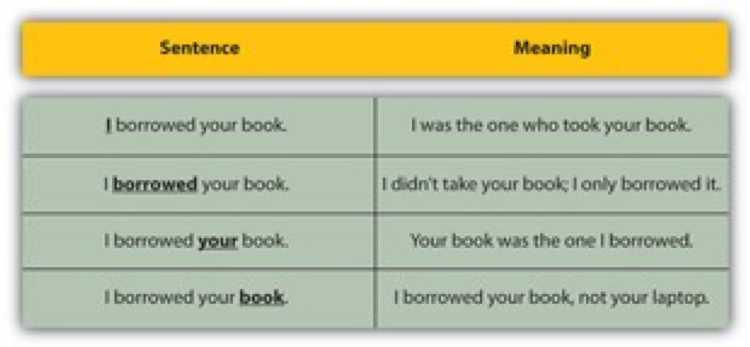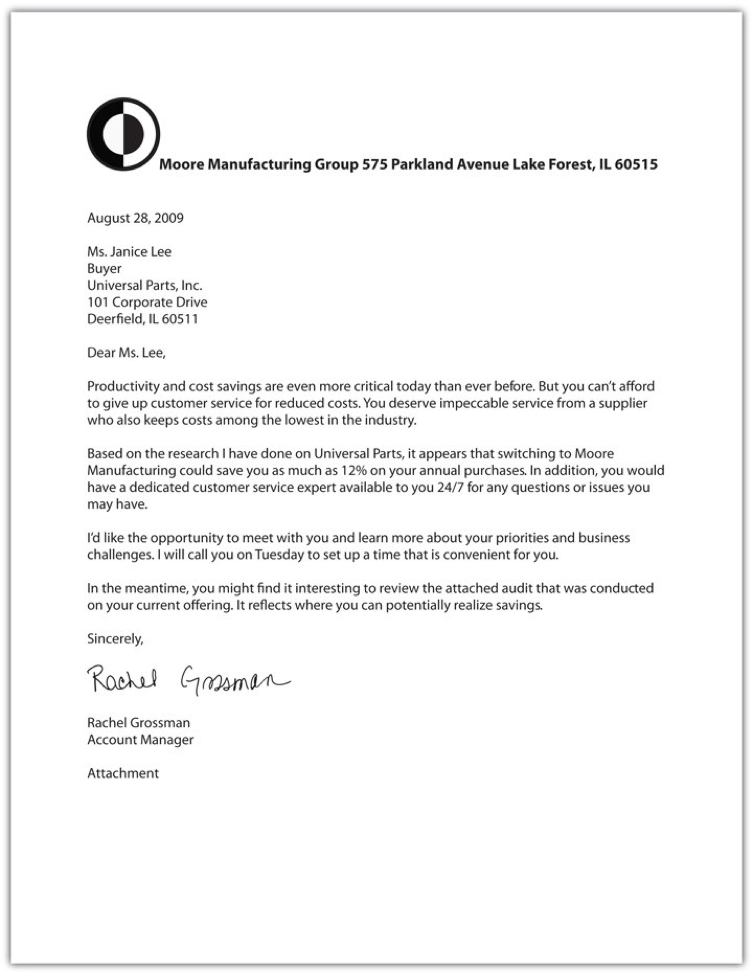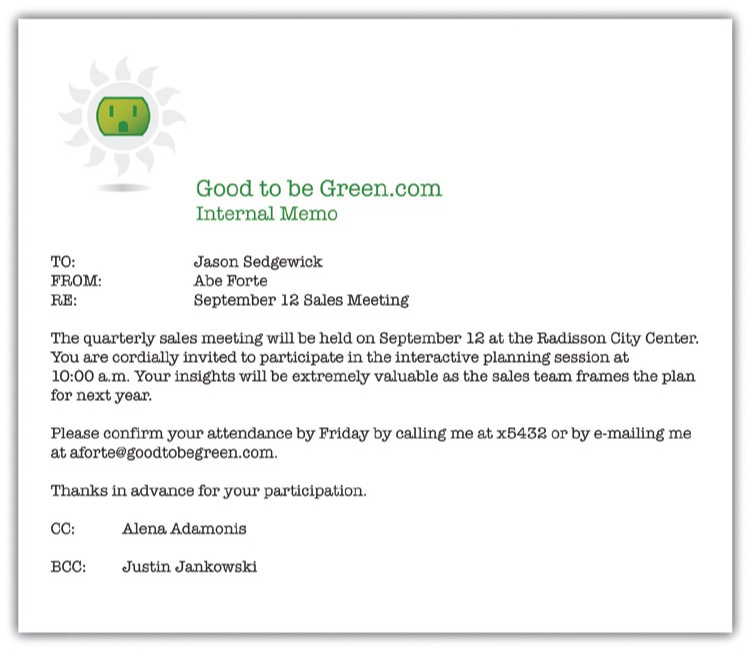5. 2. Types of Communication
It is important to use multiple types of communication so that repetition does not become boring like a broken record. There are three types of communication: verbal, which involves speaking to one or many people to convey a message; nonverbal, which includes body language and other observations about
people; and written, which includes a message that is read in hard copy, e-mail, text message, instant message, Facebook, Twitter, blog, or other Internet-based written communication. Varying the usage of these mediums can help ensure your customer’s attention, but you must carefully develop each skill separately to communicate effectively.
Verbal Communication
An introduction, a presentation, a telephone conversation, a videoconference call: these are all examples of verbal communication because information is transmitted orally. Despite the ubiquitous use of technology in the business world, verbal communication is the most common method of exchanging information and ideas. Verbal communication is powerful, fast, and natural and includes voice inflections that help senders and receivers understand the message more clearly. The downside to verbal communication is that once it is spoken, the words are essentially gone; they are preserved only in the memory of those present, and sometimes the memories of the specific words spoken vary dramatically. Recall is rarely exactly the same between two or more people.
Figure 5.4: The Impact of Intonation

Source: Based on ideas in Kiely, M. (October, 1993). When “no” means “yes.” Marketing, 7–9.
Voice inflection, the verbal emphasis you put on certain words, can have a significant impact on the meaning of what you say. In fact, the same words can take on completely different meaning based on the inflection you use.
For example, if you say the sentence in with an inflection on a different word each time, the sentence communicates something completely different each time.
Verbal communication may take place face-to-face, such as an in-person conversation or group meeting, speech, or presentation. It could also take place by phone in an individual conversation, a conference call, or even a voice mail. Other forms of verbal communication include videoconferences, podcasts, and Webinars, which are increasingly common in business. All these methods allow you to use inflection to communicate effectively. Face-to-face meetings also provide the opportunity to use and interpret other visual cues to increase the effectiveness of your communication. Verbal communication is especially important throughout the steps of the selling process. Your choice of words can make the difference in someone’s decision to first hear your sales presentation, and your presentation can determine whether that person will purchase your product or service. You will learn more specifically about how communication is used throughout the selling process covered in later chapters.
Nonverbal Communication
Imagine that you are in a retail store buying a suit for an interview. When the salesperson approaches you, they smile, makes eye contact, and shake your hand. You respond positively. You notice that they are dressed professionally, so they make you feel as if you will receive good fashion advice from them. When you make your choice, the tailor comes over wearing a tape measure around their neck. You know they are a professional and you can trust them to alter your new suit properly. On the other hand, if the salesperson waits on you only after you interrupt their personal phone call, doesn’t make eye contact or shake your hand, acts as if they are bored being at work, and is dressed in worn jeans and flip-flops, it’s unlikely that you trust them to help you choose your suit.
You have, no doubt, used and noticed nonverbal communication in virtually every personal encounter you have had. Think about it: a gesture, a smile, a nod, eye contact, what you are wearing, the fact that you are frequently checking your cell phone for text messages, and how close you stand to someone are all examples of nonverbal communication. Nonverbal communication is extremely powerful. In fact, some studies indicate that the influence from nonverbal communication such as tone and visuals can have a greater impact than the spoken words. Dr. Albert Mehrabian, a famed psychologist and professor emeritus of psychology at University of California, Los Angeles, is considered a pioneer in the area of body language and nonverbal communication. His research includes an equation, called the Mehrabian formula (Mehrabian’s communication theory, 2019) that is frequently used to define the relative impact of verbal and nonverbal messages based on experiments of communication of feelings and attitudes:
7% of meaning in the words that are spoken.
38% of meaning is paralinguistic (the way that the words are said).
55% of meaning is in facial expression.
100%
The formula reflects how we interpret meaning during communication. In the formula, you can see that only 7% of the meaning in a conversation is from the actual words spoken where as 38% is in the way we speak the words and a whopping 55% is in our facial expressions. Miscommunication occurs when facial expressions contradict words, and then people tend to believe the facial expressions ((Mehrabian’s communication theory, 2019). In sales, it would be important to recognize this to ensure that your words match your intonation and your facial expressions.
Types of Nonverbal Communication
- Handshake
- Body language
- Gestures
- Nodding or shaking your head
- Eye contact (or lack of eye contact)
- Eye roll
- Facial expressions
- Touch
- Space or proximity
- Dress
- Multitasking (e.g., texting while listening to someone, earphones in ears while working)
Your Handshake Says It All
In some countries, you might bow when you meet someone; in others you might kiss; but when you meet someone for a business meeting in most countries, it’s best to shake hands (hand shaking is used across all continents to various degrees) (Hill, n.d.). When you shake hands with people at a meeting, they are two times more likely to remember you than if you don’t shake hands (Zupek, 2009). So, it is important to understand the handshake as a business too. A good handshake is essential in business; it is the first nonverbal cue that you give to the person with whom you are meeting. It’s so important to have a good handshake that a recent study conducted at the University of Iowa showed that during mock interviews, those students who scored as having a better handshake were also considered more hirable by interviewers (Good handshake key to interview success, 2009). Do you think you have a good handshake? Believe it or not, it’s worth practicing your handshake. Here are five tips for a good handshake:
- Extend your right hand when you are approximately three feet away from the person with whom you want to shake hands (Zupek, 2009).
- Make eye contact and smile. (Mayne, 2020).
- Keep your wrist straight and lock hands connecting your hand with the same part of the other person’s hand (Zupek, 2009). Apply appropriate pressure; don’t crush the person’s hand (Mayne, 2020).
- Shake up and down three or four times (Lennon, 2018; Mayne, 2020).
- Avoid the “wet fish” handshake. This is where practice is really important. The more you shake hands, the less nervous you will be. (good handshake key to interview success, 2009).
A handshake is your opportunity to use multiple types of nonverbal communication to get your meeting or interview off to a good start.
Body Language
Do you use your hands when you talk? If so, you are using body language to help make your point. But body language includes more than talking with your hands. Body language is what we say without words; nonverbal communication using your body includes elements such as gestures, facial expressions, eye contact, a head tilt, a nod, and even where and how you sit. Body language can indicate an unspoken emotion or sentiment that a person might be feeling either consciously or subconsciously. Body language can indicate if you are listening to someone and are engaged in what they are saying, disagreeing with them, or getting bored. (You might want to think twice about the body language you are using in class.) It is important that you are aware of what you communicate with your body language and to understand and respond to the cues you are getting from someone else’s body language. Some research indicates that body language may account for between 60 and 65 percent of all communication (Foley, 2007). This number may be a little high but it is clear that body language does play a role in our communication. Here are some common body language examples and meaning (Bradbury, 2017; Cherry, 2019):
- Crossed arms and legs: resistance to your ideas
- Glancing at watch: concerned about time or bored
- Real smiles crinkle the eyes
- Raised eyebrows: discomfort
- Exaggerated nodding: anxiety about approval
- Clenched jaw: stress
- Hands on hips: ready and in control
- Tapping fingers or fidgeting: bored, impatient or frustrated
Body language is not just an interesting topic to consider; it’s a proven science that can help you improve your communication. Make eye contact with the person to whom you are speaking. Smile when you meet someone and throughout the conversation. A smile is a positive response to another person and has a significant impact on how people perceive you. A smile can break the ice and help you start a conversation. Dress for success at all times, which means always dressing appropriately for the situation. Career counsellors recommend that people dress for the job they want—not the job they currently have (this is a key body language element in the first impression (Goman, 2012). Even in very casual work environments, what you wear is a nonverbal communication about who you are. If you don’t dress for the next promotion, chances are you won’t be considered for it. Be aware of the company policy and dress code, and if in doubt, dress more conservatively.
Written Communication
Although verbal and nonverbal communications usually take place in real time, written communication has a longer consideration period. The sender must encode the message in words to be communicated on paper or a screen (Carey, 2000).Business reports, proposals, memos, e-mails, text messages, Web sites, blogs, wikis, and more are all examples of written communication. Each of them is created over a period of time and can include collaboration from multiple people. Collaboration is especially important for communicating, planning, and creating documents so many people use tools such as wikis to share documents. Written communication is preferred to verbal communication when careful consideration is important or the information needs to be permanent, such as a company policy, sales presentation, or proposal. Written communication can also take place when verbal communication is not an option, like when you need to respond to an e-mail or text message at 1:00 a.m. Although verbal communication is faster and more natural than written communication, each has its pros and cons. Generally, written communication is better at conveying facts, while verbal communication is better at conveying feelings. Verbal communication has another significant drawback: consider the fact that humans listen much faster than they speak. For example, the average public speaker speaks at about 125 words per minute. Although this sounds natural, the average person can listen at 400 to 500 words per minute. That means that listeners’ minds have time and space to wander, which can affect the effectiveness of verbal communication (Lee & Hatesohl, 1993). (You may have noticed your mind wandering during a class lecture—even if you found the topic interesting.)
Written communication requires a good command of the English language, including the rules of grammar and spelling. If you think that business exists solely on quick instant messages and text messages, you might be surprised to learn that they are only a portion of the communication within a company and between the company’s vendors and other partners. Because the nature of written communication is such that it allows time for consideration and composition, the standards for writing are much higher than for a casual conversation. Customers and colleagues alike expect clear, concise written communications with proper grammar and spelling. Moreover, because written communication is long lasting—whether on paper or on the Internet—errors or misstatements exist for an irritatingly long time. So whether you are writing a proposal, a presentation, a report, a meeting recap, or a follow-up e-mail, it’s best to take the time to think about your communication and craft it so that it is effective. Consider using the following tips:
- Be short and sweet: Shorter is always better when it comes to business correspondence. It’s best to include all pertinent facts with concise information. If you write your communication with the receiver in mind, it will be easier to make it shorter and more effective.
- Grammar, please: Sentences should be structured correctly and use proper grammar, including a subject and a verb in each sentence. Upper and lower case letters with proper grammar provides a good first impression regardless if you are writing a memo, letter, blog or social media post (Scaros, 2016). If writing is not your strong suit, visit your campus student services office or learning center to provide information about upcoming writing clinics and access to other tools that can help improve your writing skills.
- Check spelling: Use the spell-check tool on your computer. There is no excuse for a misspelled word. Text abbreviations are not acceptable in business correspondence.
- Read before you send: Reread your document or electronic communication before it goes out. Is everything complete? Is it clear? Is it something you will be proud of days or weeks later? Take the extra time to review before you send. It is difficult to revise a communication as revisions cause confusion.
- Just the facts: Stick to the facts to maximize the impact of your written communications; leave the emotional topics for verbal dialogue. For example, send an e-mail to confirm meeting time, date, and location; use a verbal communication for the content of the meeting to be discussed, such as a negotiation.
Figure 5.3: Company letter example

Figure 5.4 Memo example

Which Is Best?
Although verbal, nonverbal, and written communication all play a role in your communication with your customers, you might be wondering which one is best. It depends on your customer and on the situation. Some customers want to work day to day using all the latest technology tools, including text messaging, social networking, Web conferences, wikis, and more. Other customers prefer more traditional face-to- face meetings, phone calls, and some e-mail correspondence. Adapt to the method of communication that your customer prefers and not the other way around. In some situations, a face-to-face meeting is best— for instance, if you wish to discuss a complex issue, negotiate, or meet some additional members of the team. Sometimes, a face-to-face meeting isn’t feasible, so other verbal communication methods such as a videoconference, phone call, or conference call can be efficient and effective if used properly. Chances are you will use a combination of communication types with each customer tailored to their particular preferences and situation. Be guided by the fact that you want to keep your communication personal in meaning and professional in content. Think about it from the receiver’s point of view, and deliver bad news verbally whenever possible.

